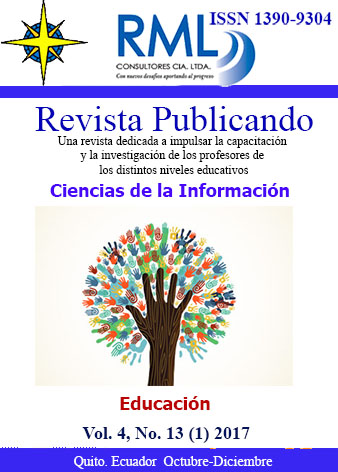Resumen
In this article, we provide the reader with an idea of realisation an interactive web system for virtual reality (VR). First, we discuss the role of web system for VR, and its relevance and importance. Then, we provide a brief overview of the existing technologies, which allows to implement this idea at the software level. Particularly, we review the possibilities of implementing the functions of the system, which will be gathered in one place: display of standard video and video 360 °, with dynamic playlist and descriptions windows; online maps, where the mode of «street view » will be in the focus of attention; output web pages, based on automatic transformation or ready-made «VR mode » of WebVR technology; and the adaptation of the browser to VR, which should solve one of the important problems – user-friendly navigation and ensuring high performance because VR in web has a lot of extra interlayers, instructions translation and etc., and this all decreases the performance. Thus, we are attempting to swap them and make a web-system in the virtual reality system. At the same time, we present our concepts, which clearly demonstrate our idea. Finally, we offer some possible ways of our web-system development in the future.
Referencias
Abramov Vitaly, Kugurakova Vlada, Rizvanov Albert, Abramskiy Mikhail, Manakhov Nadir, Evstafiev Mikhail, and Ivanov Denis. 2017. Virtual Biotechnological Lab Development. BioNanoScience 7, 2 (01 Jun 2017), 363–365. DOI: 10. 1007/s12668-016-0368-9
Best VR web browser: how to browse the internet in virtual reality. Retrieved from www.techradar.com/news/internet/web/best-vr-web-browser-how-to-browse-the-internet-in-virtual-reality-1317762
Cervantes Edgar. 2016. Best VR browsers – immerse yourself into the web. (2016). http://vrsource.com/best-vr-browsers-immerse-web-5538
GitHub repository: Comparison of OpenGL and Vulkan API in terms of performance. Retrieved from github.com/RippeR37/GL_vs_VK
Barsoum Emad and Kuester Falko. 2005. WebVR: an interactive web browser for virtual environments. Proc. SPIE 5664 (2005), 540–547. DOI: 10.1117/12. 582624
Google Developers. 2017. Web Fundamentals: WebVR. (2017). https://developers. google.com/web/fundamentals/vr
Hedelin Hugo. 2017. Design and evaluation of a user interface for a WebVR TV platform developed with A-Frame. Master”™s thesis. Linkí¶ping University, Department of Computer and Information Science.
Khronos.org. 2015. Vulkan - Graphics and compute belong together. (2015). https://www.khronos.org/vulkan/
Larabel Michael. 2017. GL_vs_VK: A Micro-Benchmark Looking At The Overhead Of OpenGL vs. Vulkan APIs. (2017). Retrieved from http://www.phoronix.com/scan.php?page=article&item=gl-vs-vk
Mozilla VR team. 2017. Introduction – A-Frame. (2017). Retrieved from https://aframe.io/docs/0. 6.0/introduction
Manakhov Nadir, Kugurakova Vlada, Abramskiy Mikhail, Abramov Vitaly, and Maslaviev Azat. 2017. Visual editor of scenarios for virtual laboratories (10th International Conference on the Developments on eSystems Engineering). Paris, France.
Pakkanen T., J. Hakulinen, T. Jokela, I. Rakkolainen, J. Kangas, P. Piippo, R. Raisamo, and M. Salmimaa. 2017. Interaction with WebVR 360; video player: Comparing three interaction paradigms. (March 2017), 279–280. DOI: 10.1109/VR.2017.7892285
Samsung Internet for Gear VR. Retrieved from
www.oculus.com/experiences/gear-vr/849609821813454
Splitt Martin. 2016. Martin Splitt - A journey to WebVR. NLHTML5 - front-end meetup group, Amsterdam, Netherlands. (26 Jule 2016). https://www.youtube. com/watch?v=8lXFCIbOgmQ
Qian Feng, Lusheng Ji, Bo Han, and Vijay Gopalakrishnan. 2016. Optimizing 360 Video Delivery over Cellular Networks. 1–6. DOI: 10.1145/ 2980055.2980056
WebVR Rocks. 2017. WebVR Rocks: Your guide to VR on the Web. (2017). https://webvr.rocks
Zheng ,Vincent. 2017. Web VR is The Future Virtual Reality Content For Browser. (2017). Retrieved from https://blog.visualpathy.com/what-is-webvr
Usted es libre de:
Compartir — copiar y redistribuir el material en cualquier medio o formato
Adaptar — remezclar, transformar y construir a partir del material
La licenciante no puede revocar estas libertades en tanto usted siga los términos de la licencia
Bajo los siguientes términos:
Atribución — Usted debe dar crédito de manera adecuada, brindar un enlace a la licencia, e indicar si se han realizado cambios. Puede hacerlo en cualquier forma razonable, pero no de forma tal que sugiera que usted o su uso tienen el apoyo de la licenciante.
NoComercial — Usted no puede hacer uso del material con propósitos comerciales.
CompartirIgual — Si remezcla, transforma o crea a partir del material, debe distribuir su contribución bajo la lamisma licencia del original.
